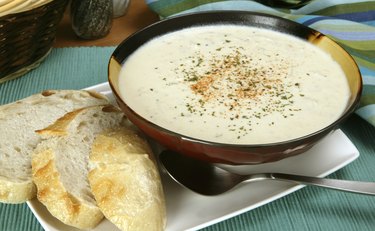
A bowl of thick, steaming chowder is an iconic East Coast food, equal in significance to Boston's baked beans or Maine's lobster roll. The earliest known versions were very simple, made of whatever fish were available and thickened with ship's biscuit pounded to a floury powder. The now-canonical form of clam chowder made with milk or cream and thickened with flour only emerged in the middle of the 19th century.
Pros and Cons of Flour
Video of the Day
Vintage recipes often called for a roux of flour cooked in the fat from rendered-out salt pork. Flour ordinarily takes 20 to 30 minutes to fully cook and thicken a soup, but heating it in the fat pre-cooks the starch granules and speeds the process. Fat also coats the granules and deters the formation of lumps when you add broth. Chowder prepared with roux has a silky and hearty texture, but if you misjudge proportions, the finished chowder can be too thick or too thin. Fast-acting instant or "gravy" flour can salvage a thin chowder, and thick ones can be thinned with extra milk.
Video of the Day
Alternative Thickeners
If you want to lower your soup's fat content or avoid the use of flour, other thickeners are suitable. Cornstarch acts quickly and is gluten-free. If you have leftovers, they'll tend to set to a stodgy temperature, but the soup will thin again when heated and stirred. Arrowroot powder is harder to find but works similarly. It's the best starch thickener if you freeze chowder, retaining its texture when thawed. Potato starch is another excellent choice, thickening even more rapidly and powerfully than cornstarch, then relaxing to a rich, flour-like silkiness.